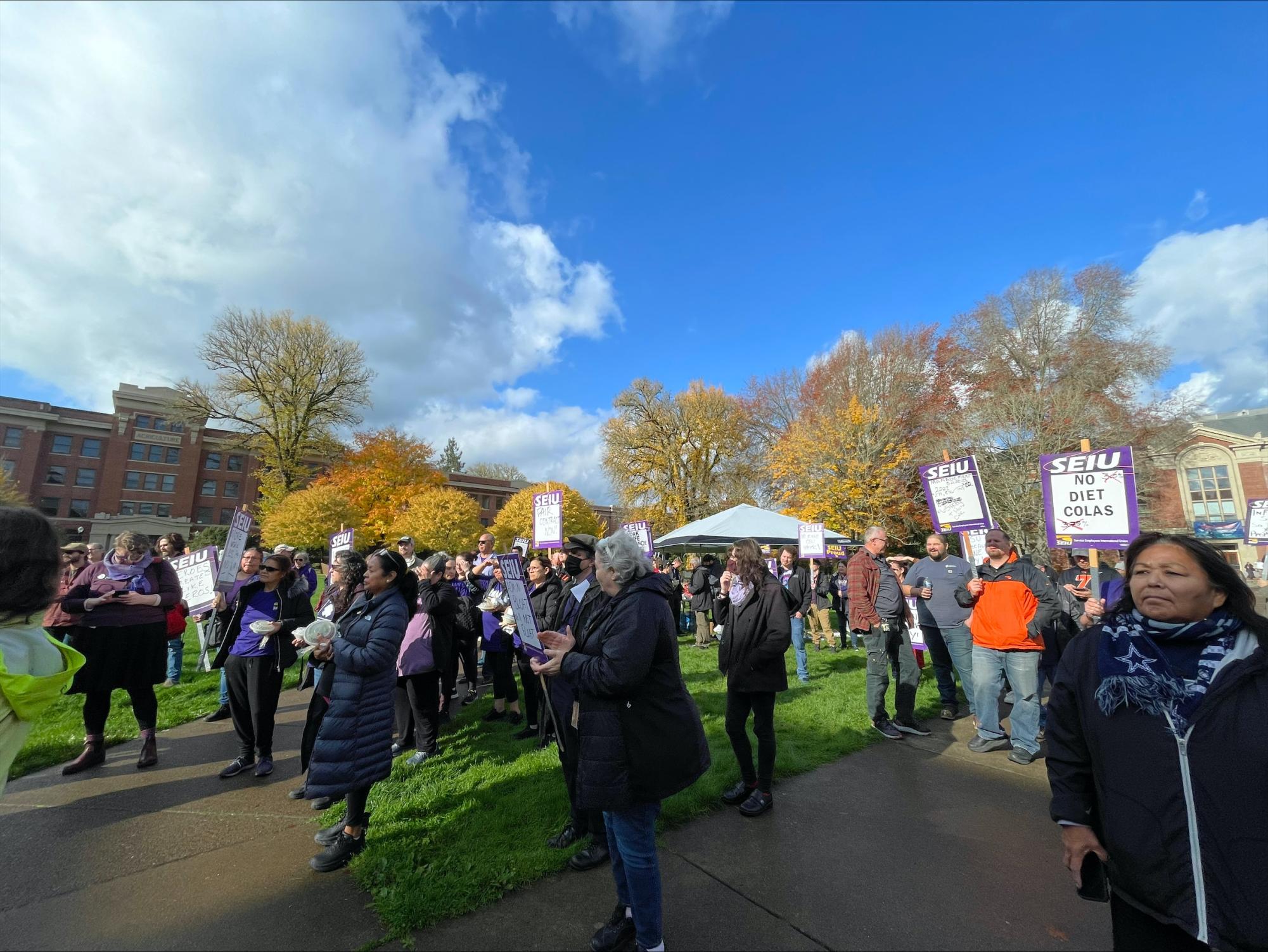Editor’s note: One of the institutions was incorrectly named. The proper name is “Oregon Institute of Technology.”
Many different organizations have tables set up in the Oregon State University library quad at any given time, but on Nov. 7, something about the Service Employees International Union table in the quad stood out – maybe it was the free Chipotle burritos.
On Nov. 7, union representatives of SEIU 503 and union employees held a rally in front of the Valley Library and the Kerr Administration Building to protest their current contracts with the seven public universities in Oregon: Eastern Oregon University, Oregon Institute of Technology, Oregon State University, Portland State University, Southern Oregon University, University of Oregon and Western Oregon University.
According to the SEIU 503 website, union members filled out a bargaining survey last summer and want to prioritize respect for classified staff, fair wages that keep pace with the cost of living, safe working conditions and maintaining a strong union.
The demonstration was organized by the members of the SEIU through word of mouth – emails, calls and social media posts spread the word about the march.
Steve Clark, part-time communications director for OSU, has been assisting all of Oregon’s seven public universities in joint collective bargaining with SEIU-represented classified employees, and responded to questions on behalf of the university.
According to Clark, Oregon’s seven public universities are engaged in negotiations with SEIU in relation to an economic reopener of their current contract, which expires in June of 2026.
Bargaining teams from the SEIU and Oregon’s seven public universities have met three times so far to negotiate wage provisions at Oregon Institute of Technology, University of Oregon and Oregon State University, with future sessions scheduled to be held at Western Oregon University and Portland State University.
Union representatives and members plan to revisit the contract with each university, and each bargaining session will be a two-day affair.
“We bargain at each university to make sure that our membership has the access to us as a bargaining delegate,” said Mark Dunbar, union president of SEIU 503’s sub-local 83 division.
As union president, Dunbar works as a fiscal coordinator and represents union employees at OSU, as well as working for the union as one of the bargaining delegates.
SEIU 503, as a whole, represents over 72,000 employees in Oregon, including many in the public sector. According to Dunbar, they represent about 4,500 employees between the seven universities in Oregon.
“Our contract is 66 articles and letter agreements that govern the minimum way they have to work with us as employees,” Dunbar said. “It includes our salary compensation, health benefits, time off, union rights, employee rights and a myriad of other things.”
According to Dunbar, the cost of living adjustments – also called COLAs – that are written in the contract aren’t keeping up with inflation, nor the actual cost of living.
After the march on Nov. 7, the SEIU bargaining team revised its salary proposal from the one stated on their website, and is now asking for a 12% raise as opposed to a 13% raise retroactive to July 1 2023, a 9% raise as opposed to a 10% raise effective July 1, 2024, and a 7% raise as opposed to an 8% raise effective July 1, 2025.
In an email, Clark said that “Oregon’s universities will fairly consider proposals provided by SEIU, while taking into account inflation that impacts employees and each university, as well as the need for each university to operate in a financially sustainable manner.”
The request from the union, according to Clark, may not be feasible to accommodate: “SEIU’s current proposal for raises of 12%, 9%, and 7% over the next three years and a $2,250 per person bonus would cost $267 million through June 30, 2026. This represents an 83% increase from the current full cost of classified employee wages,” Clark said.
According to Jessica King, vice president of SEIU 503’s sub-local 83 division, the SIEU negotiated the five-year contract with the stipulation that, in the middle of the contract, they would reopen it and look at things, like the cost of living, and reevaluate.
“Classified staff and the people that support us are out here rallying for respect,” King said when asked about the goal of the SEIU demonstration. “We would love the universities to see the value in the work that we do and what we provide, not only for our students, but in keeping this university running.”
King said that some members are unable to make ends meet with what they are being paid by the universities and some have to work second jobs in order to stay afloat.
When asked about adjustments for inflation, King said, “even though inflation has started trending downward … we’re not seeing that in the price of goods, in the price of gasoline, in the price of food, in the price of childcare, and those things really impact our members.”
King said the SEIU hopes that the OSU administration will know how serious the union is about what it is asking from the administration.
“We think that what they are proposing is unfair,” King said. “We don’t think that what they’re proposing is livable for the situation that we are in.”
The work of classified staff is often unseen by the general OSU community – including custodians, informational technologists, receptionists, librarians, and facilities and maintenance personnel. They feel that their work is “deeply undervalued” by the university, according to King.
“Our university would not run without classified staff. Classified staff are the backbone of our university,” said Matteo Paola, member of the OSU student workers organizing committee and former ASOSU student body president.
According to Joseph Orosco, professor of philosophy at OSU and president of United Academics, OSU’s faculty union, the SEIU 503 members are “going to be watching to see how things go to learn and to figure out how (they) can work with the administration.”
Future bargaining sessions are scheduled to be held Nov. 29, Nov. 30 and Dec. 1 at PSU, and Dec. 14 and 15 at WOU.












































































































